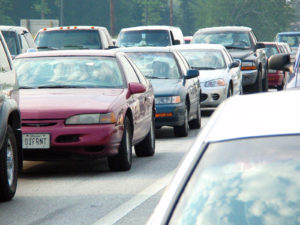By George Harvey
The American Lung Association in California (ALAC) has put a number on the external costs of the use of fossil fuels for transportation in their state. Their report, The Road to Clean Air, also provides comparable numbers for nine other states, seven of which are in the Northeast. The costs relate almost entirely to medical expenses and missed days at work or school.
According to the ALAC, these external costs in the Northeast range from a low of $360 per person per year in New York and Connecticut to $480 per person per year in Vermont. Vermonters tend to drive more than New Yorkers, so they use more fuel per person, producing more pollution per person from automobiles. The result is that they spend more on medical expenses and lose more time at work.
We should bear in mind that these figures are per person, per year. The actual average cost for a family of five, for example, would be five times as great. So an average family of five in Vermont is losing $2,400 per year to the external costs of transportation. As bad as that sounds, it is only about half of the total external cost of fossil fuel use to Vermonters, because roughly half of the use of fossil fuels is for heating and industry, with a much smaller amount from other sources. That would drive up the external costs of fossil fuel use for that typical family of five to nearly $5,000 per year.
Most people find such a figure hard to believe, unless someone in the family suffers from the conditions that are associated with air pollution, asthma, emphysema, lung cancer, other chronic pulmonary disorders, or circulatory problems. The true costs, however, are largely hidden in medical insurance and taxes, which means that most people are unaware of them.
Such numbers should really come as no surprise to anyone following the news on external costs of fossil fuels. The World Health Organization (WHO), for example, has made estimates both of the external costs and of the numbers of people who die prematurely. Other organizations have also studied the situation, producing somewhat similar results. The estimates range from about $250 to $1,000 per person, per year, worldwide in hidden costs.
Clearly, the brunt of the financial costs would fall on people who can bear them. People in societies too poor to bear such costs must go without medical help, and this suppresses the average expenses. Poor people bear their costs by the alternative, which is often simply to die.
Premature deaths associated with outdoor air pollution (1) are estimated by the WHO at about one person, worldwide, every eight and a half seconds. The International Energy Agency provides a somewhat different picture, with one person dying every ten and a half seconds. Either way, the numbers of premature deaths from outdoor air pollution, the overwhelming bulk of which come from fossil fuels, is comparable to deaths among military personnel during the World War II.
The situation is especially bad for children, and this is particularly true in poorer areas of the world. UNICEF says that about 600,000 children die from disease caused by or made worse by air pollution every year. That is another child about every 52.6 seconds.
But it is in nature that the situation is worst. According to the WWF, we have lost over 58% of vertebrate animal populations worldwide since 1970, and at the rate numbers are declining, we will lose two-thirds by 2020. Most of the declines are due to problems stemming from our use of fossil fuels.
These are problems that are caused by nearly everyone. We kill people, children, and animals by heating with oil, by cooking with propane or natural gas, by driving cars powered by diesel oil or gasoline, and by eating food brought to use from such distant places as Iowa and California. That is the bad news.
The good news is that we can stop the war on human health, human life, and nature by switching away from fossil fuels and toward use of renewable energy sources. And part of that good news is that we will not only save lives and the environment, but we can live more comfortably and save money in the process. How much money? It depends on where you live. Per person, per year, it is about $360 in New York, and about $480 in Vermont.
The Road to Clean Air can be found at bit.ly/road-to-clean-air.
********************************************************************************************************************************************************************************************************************
(1) Another resource on clean air is Good Air Geeks. Click here to read “Everything You Need to Know About Air Pollition.”









Leave a Reply